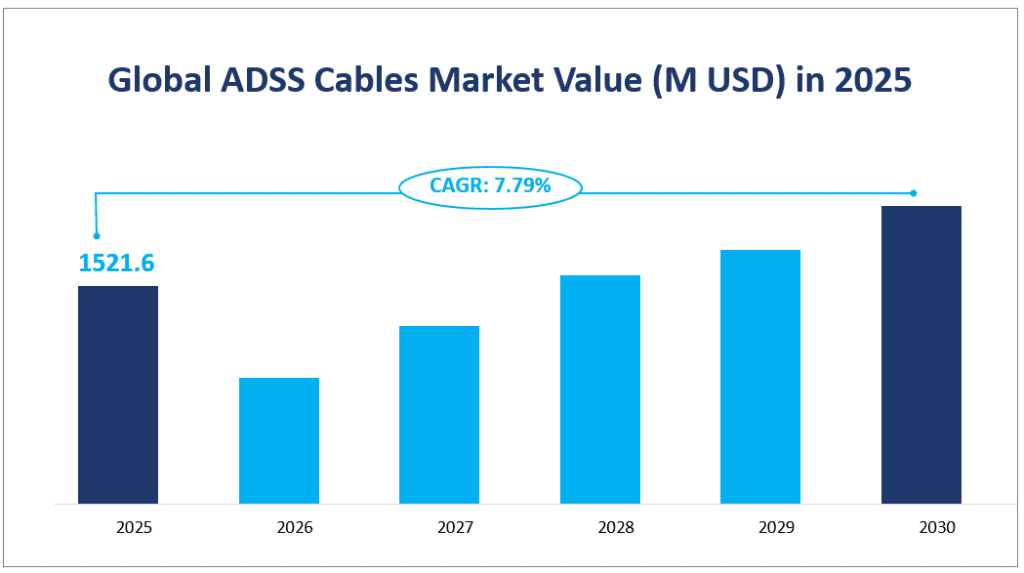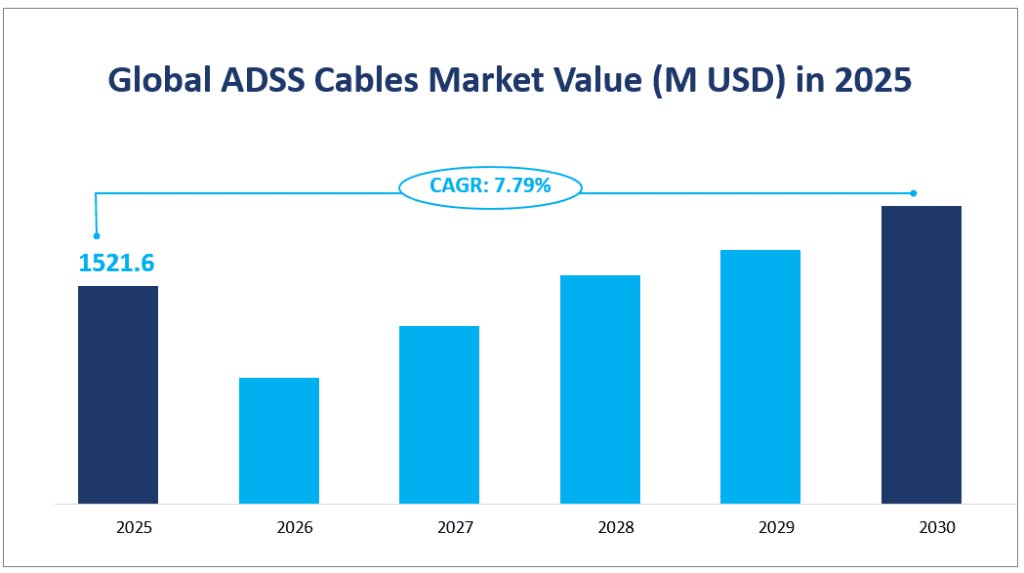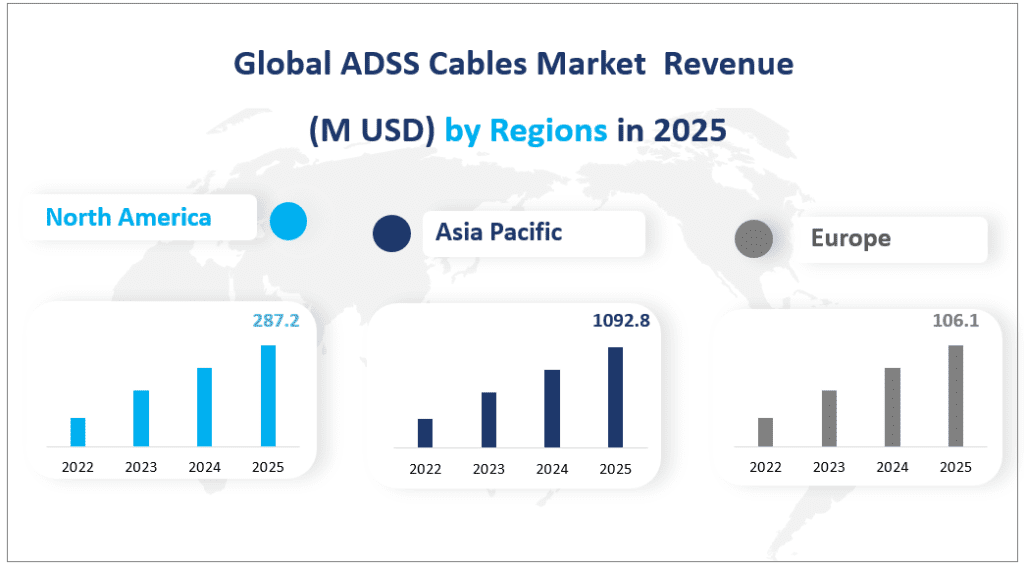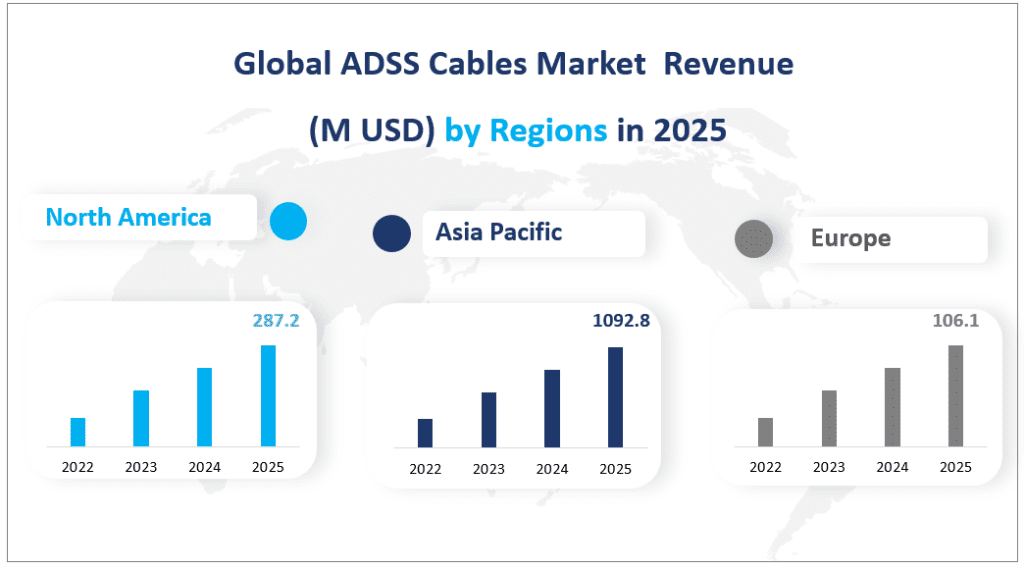1. Global ADSS Cables Market Analysis
In 2025, the global ADSS Cables market is projected to reach a revenue of $1,521.6 million with a CAGR of 7.79% from 2025 to 2030.
ADSS cables are a specialized type of fiber optic cable designed for aerial installations without the need for support or messenger wires. These cables are self-supporting and are constructed with non-metallic elements, making them ideal for use in environments where metallic conductors are not feasible. The cables are designed to withstand harsh weather conditions, including high winds and ice loads, and are capable of spanning long distances between support structures. ADSS cables are particularly beneficial for power utilities, private networks, and other applications requiring high reliability and minimal maintenance.
Global ADSS Cables Market Value (M USD) in 2025


2. Driving Factors of ADSS Cables Market
Technological Advancements: The continuous evolution of fiber optic technology has significantly enhanced the performance and reliability of ADSS cables. Innovations in material science and manufacturing processes have led to cables that are lighter, stronger, and more durable. These advancements enable ADSS cables to support longer spans and withstand more challenging environmental conditions, making them an attractive option for various applications.
Increasing Demand for High-Speed Communication: The growing need for high-speed internet and reliable communication networks has driven the demand for ADSS cables. With the expansion of broadband services, smart grids, and the Internet of Things (IoT), there is a heightened requirement for efficient and robust fiber optic infrastructure. ADSS cables offer a cost-effective and reliable solution for deploying fiber optic networks in both urban and rural areas.
Rising Adoption in Power Utilities: Power utilities are a significant end-use segment for ADSS cables. The cables are used for communication and control systems in power transmission and distribution networks. The increasing investment in smart grid technologies and the need for real-time monitoring and control of power systems have led to a higher adoption rate of ADSS cables in this sector.
Government Support and Policies: Governments around the world are promoting the development of advanced communication infrastructure to support economic growth and improve public services. Policies and initiatives aimed at expanding broadband access and modernizing power grids have created a favorable environment for the growth of the ADSS cables market.
3. Limiting Factors of ADSS Cables Market
Intense Market Competition: The ADSS cable market is highly competitive, with several established players vying for market share. This competition can lead to aggressive pricing strategies, which may compress profit margins for manufacturers. Additionally, the need for continuous innovation and investment in research and development to stay ahead of competitors can be a significant challenge for smaller players.
Raw Material Price Fluctuations: The cost of raw materials, such as optical fibers, aramid yarns, and various plastics, can fluctuate due to market conditions and supply chain disruptions. These fluctuations can impact the production costs and profitability of ADSS cable manufacturers. Ensuring a stable and cost-effective supply of raw materials is crucial for maintaining competitiveness in the market.
Regulatory and Environmental Challenges: The deployment of ADSS cables in certain regions may face regulatory hurdles and environmental concerns. Compliance with local regulations regarding installation, maintenance, and environmental impact can add to the complexity and cost of projects. Additionally, the need to address environmental sustainability and reduce the carbon footprint of manufacturing processes is becoming increasingly important.
4. Analysis of ADSS Cables Market Segment
Product Types
By 2025, the market revenue for ADSS Flextube is projected to reach $64.3 million. This product type is known for its flexibility and ease of installation, making it highly suitable for applications requiring shorter spans and frequent access points. The design of ADSS Flextube cables includes a micromodule structure with a high-density polyethylene sheath, reinforced with non-metallic materials. This construction ensures high tensile strength and dielectric capability, making it ideal for environments where reliability and durability are paramount.
The ADSS Loose Tube market is significantly larger and is projected to generate a revenue of $1457.4 million by 2025. This product type is characterized by its traditional loose tube design, which allows for greater flexibility and adaptability in various environmental conditions. The loose tube structure provides stable performance over a wide temperature range and is compatible with any telecommunications-grade optical fiber. This versatility makes ADSS Loose Tube the preferred choice for long-span applications, including aerial networks and power transmission lines.
In terms of market share, ADSS Loose Tube holds the largest portion of the ADSS Cables market, accounting for over 95% of the total revenue in 2025. This significant market share is attributed to its versatility, reliability, and suitability for a wide range of applications. On the other hand, ADSS Flextube, while important for specific applications, holds a much smaller share of the market.
Applications of the ADSS Cables Market
The Power Utilities segment is the largest application area for ADSS Cables, with a projected market revenue of $1128.8 million by 2025. This segment encompasses the use of ADSS Cables in power transmission and distribution networks, where reliable and efficient communication is crucial. The cables are used for monitoring, control, and protection systems in power grids, ensuring the smooth operation and management of electrical power systems.
The growth rate of the Power Utilities segment is robust. This significant growth is driven by the increasing investment in smart grid technologies and the need for real-time monitoring and control of power systems. The expansion of renewable energy sources and the integration of distributed energy resources also contribute to the demand for ADSS Cables in this segment.
The Private Networks segment is another significant application area, with a projected market revenue of $126.9 million by 2025. This segment includes the use of ADSS Cables in private communication networks, such as those operated by enterprises, government agencies, and other organizations. The cables are used for data transmission, voice communication, and other network services within these private networks.
The growth rate of the Private Networks segment is also notable. This growth is driven by the increasing demand for high-speed, reliable communication networks in various industries. The need for secure and efficient data transmission within private networks is a key factor driving the adoption of ADSS Cables in this segment.
In terms of market share, the Power Utilities segment holds the largest portion of the ADSS cable market, accounting for over 74% of the total revenue in 2025. This significant market share is attributed to the critical role of ADSS Cables in power transmission and distribution networks. The growing investment in smart grid technologies and the increasing demand for real-time monitoring and control of power systems further solidify the dominance of this segment.
Market Value by Segment
| Market Value (M USD) in 2025 | ||
| By Type | ADSS Flextube | 64.3 |
| ADSS Loose Tube | 1457.4 | |
| By Application | Power Utilities | 1128.8 |
| Private Network | 126.9 |
5. Regional ADSS Cables Market
The Asia-Pacific region is the largest market for ADSS Cables, with a projected revenue of $1,092.8 million by 2025. This region’s dominance is attributed to rapid economic development and increasing investment in infrastructure, particularly in countries like China and India. The region’s growth is further bolstered by the expansion of broadband services, smart grids, and the Internet of Things (IoT).
North America is the second-largest market, with a projected revenue of $287.2 million by 2025. The region’s market is characterized by a high level of technological maturity and significant investment in modernizing existing infrastructure. The United States and Canada are key markets within this region, with substantial contributions from major players like Corning and Prysmian.
Europe is another significant market, with a projected revenue of $106.1 million by 2025. The region’s market is characterized by a focus on sustainability and advanced technological solutions. European countries are investing heavily in smart grid technologies and renewable energy integration, driving the demand for ADSS Cables.
South America is a growing market, with a projected revenue of $28.6 million by 2025. The region’s market is characterized by increasing investment in infrastructure development, particularly in countries like Brazil and Argentina. The Middle East & Africa region is an emerging market, with a projected revenue of $7.0 million by 2025. The region’s market is characterized by increasing investment in power utilities and communication infrastructure, particularly in countries like Saudi Arabia and the UAE.
The global ADSS Cables market is characterized by significant contributions from major regions, each with distinct market dynamics and growth trajectories. The Asia-Pacific region holds the largest market share, driven by rapid economic development and increasing investment in infrastructure. North America and Europe also play significant roles, with substantial contributions from major players and a focus on technological advancements.
Global ADSS Cables Market Revenue (M USD) by Regions in 2025


6. Analysis of Top 3 Companies in the ADSS Cables Market
Company Introduction and Business Overview
Fujikura Ltd is a global leader in the development and manufacturing of power and telecommunication systems products. Established in 1984, the company is headquartered in the United States and operates manufacturing sites in both the US and Japan. Fujikura is renowned for its innovative products, including devices for optical fibers such as cutters and splicers.
Products Offered
Fujikura offers a wide range of ADSS Cables, including AFL-ADSS® and AFL Mini-Span®. These cables are designed for aerial and duct applications, providing reliable and efficient solutions for power utilities and private networks. The company’s products are known for their high tensile strength, lightweight design, and excellent performance in harsh environmental conditions.
In 2021, Fujikura Ltd generated a revenue of $157.3 million from its ADSS Cables business.
Company Introduction and Business Overview
Prysmian is an Italian company with a long history dating back to 1879. The company is a global leader in the production of electrical cables for the energy and telecom sectors. Prysmian operates manufacturing sites in several countries, including the US, Mexico, Brazil, and various European countries. The company is known for its innovative solutions and high-quality products.
Products Offered
Prysmian offers a comprehensive range of ADSS Cables, designed for aerial installations in both distribution and transmission environments. The company’s ADSS Cables are known for their non-metallic construction, high tensile strength, and excellent performance in harsh weather conditions. Prysmian’s products are widely used in power utilities, private networks, and other applications requiring reliable communication infrastructure.
In 2021, Prysmian generated a revenue of $120.0 million from its ADSS Cables business.
Company Introduction and Business Overview
Corning is a leading innovator in materials science, with a history spanning over 169 years. The company is headquartered in the United States and operates manufacturing sites in the US, China, and India. Corning is known for its expertise in glass science, ceramics science, and optical physics, and its products are used in a wide range of industries.
Products Offered
Corning offers a variety of ADSS Cables, including aerial cables designed for long spans and harsh environmental conditions. The company’s ADSS Cables are known for their reliability, high tensile strength, and excellent performance in various applications. Corning’s products are widely used in power utilities, private networks, and other sectors requiring robust communication infrastructure.
In 2021, Corning generated a revenue of $111.6 million from its ADSS Cables business.
Major Players
| Company Name | Headquarters | Market Distribution |
| Fujikura Ltd | US | Worldwide |
| Prysmian | Italy | Worldwide |
| Corning | US | Worldwide |
| ZTT | China | Worldwide |
| Furukawa | Japan | Worldwide |
| Hengtong Cable | China | Worldwide |
| YOFC | China | Worldwide |
| LS Cable & System | Korea | Worldwide |
| FiberHome | China | Worldwide |
| SDGI Photoelectricity Technologies | China | Worldwide |
| Incab America | US | Mainly in America, Europe, and Asia |
| Futong Group | China | Mainly in Asia, Europe, America |
| Tongguang Cable | China | Worldwide |
| Huiyuan Optical Communications | China | Mainly in Asia and Europe |
Chapter 1: Low Vision Aids Introduction and Market Overview
1.1 Objectives of the Study
1.2 Overview of Low Vision Aids
1.3 Scope of The Study
1.3.1 Key Market Segments
1.3.2 Players Covered
1.3.3 COVID-19’s impact on the Low Vision Aids industry
1.4 Methodology of The Study
1.5 Research Data Source
Chapter 2: Executive Summary
2.1 Market Overview
2.1.1 Global Low Vision Aids Market Size, 2015 – 2020
2.1.2 Global Low Vision Aids Market Size by Type, 2015 – 2020
2.1.3 Global Low Vision Aids Market Size by Application, 2015 – 2020
2.1.4 Global Low Vision Aids Market Size by Region, 2015 – 2025
2.2 Business Environment Analysis
2.2.1 Global COVID-19 Status and Economic Overview
2.2.2 Influence of COVID-19 Outbreak on Low Vision Aids Industry Development
Chapter 3: Industry Chain Analysis
3.1 Upstream Raw Material Suppliers of Low Vision Aids Analysis
3.2 Major Players of Low Vision Aids
3.3 Low Vision Aids Manufacturing Cost Structure Analysis
3.3.1 Manufacturing Cost Structure of Low Vision Aids
3.3.2 Labor Cost of Low Vision Aids
3.4 Market Distributors of Low Vision Aids
3.5 Major Downstream Buyers of Low Vision Aids Analysis
3.6 The Impact of Covid-19 From the Perspective of Industry Chain
3.7 Regional Import and Export Controls Will Exist for a Long Time
Chapter 4: Global Low Vision Aids Market, by Type
4.1 Global Low Vision Aids Value and Market Share by Type (2015-2020)
4.2 Global Low Vision Aids Production and Market Share by Type (2015-2020)
4.3 Global Low Vision Aids Value and Growth Rate by Type (2015-2020)
4.3.1 Global Low Vision Aids Value and Growth Rate of Optical Aids (2015-2020)
4.3.2 Global Low Vision Aids Value and Growth Rate of Non-Optical Aids (2015-2020)
4.3.3 Global Low Vision Aids Value and Growth Rate of Electronic Aids (2015-2020)
4.4 Global Low Vision Aids Price Analysis by Type (2015-2020)
Chapter 5: Low Vision Aids Market, by Application
5.1 Downstream Market Overview
5.2 Global Low Vision Aids Consumption and Market Share by Application (2015-2020)
5.3 Global Low Vision Aids Consumption and Growth Rate by Application (2015-2020)
5.3.1 Global Low Vision Aids Consumption and Growth Rate of Hospital Pharmacies (2015-2020)
5.3.2 Global Low Vision Aids Consumption and Growth Rate of Professional Retail Store (2015-2020)
5.3.3 Global Low Vision Aids Consumption and Growth Rate of Optical Stores (2015-2020)
5.3.4 Global Low Vision Aids Consumption and Growth Rate of Online Stores (2015-2020)
Chapter 6: Global Low Vision Aids Market Analysis by Regions
6.1 Global Low Vision Aids Sales, Revenue and Market Share by Regions
6.1.1 Global Low Vision Aids Sales by Regions (2015-2020)
6.1.2 Global Low Vision Aids Revenue by Regions (2015-2020)
6.2 North America Low Vision Aids Sales and Growth Rate (2015-2020)
6.3 Europe Low Vision Aids Sales and Growth Rate (2015-2020)
6.4 Asia-Pacific Low Vision Aids Sales and Growth Rate (2015-2020)
6.5 Middle East and Africa Low Vision Aids Sales and Growth Rate (2015-2020)
6.6 South America Low Vision Aids Sales and Growth Rate (2015-2020)
Chapter 7: North America Low Vision Aids Market Analysis by Countries
7.1 The Influence of COVID-19 on North America Market
7.2 North America Low Vision Aids Sales, Revenue and Market Share by Countries
7.2.1 North America Low Vision Aids Sales by Countries (2015-2020)
7.2.2 North America Low Vision Aids Revenue by Countries (2015-2020)
7.3 United States Low Vision Aids Sales and Growth Rate (2015-2020)
7.4 Canada Low Vision Aids Sales and Growth Rate (2015-2020)
7.5 Mexico Low Vision Aids Sales and Growth Rate (2015-2020)
Chapter 8: Europe Low Vision Aids Market Analysis by Countries
8.1 The Influence of COVID-19 on Europe Market
8.2 Europe Low Vision Aids Sales, Revenue and Market Share by Countries
8.2.1 Europe Low Vision Aids Sales by Countries (2015-2020)
8.2.2 Europe Low Vision Aids Revenue by Countries (2015-2020)
8.3 Germany Low Vision Aids Sales and Growth Rate (2015-2020)
8.4 UK Low Vision Aids Sales and Growth Rate (2015-2020)
8.5 France Low Vision Aids Sales and Growth Rate (2015-2020)
8.6 Italy Low Vision Aids Sales and Growth Rate (2015-2020)
8.7 Spain Low Vision Aids Sales and Growth Rate (2015-2020)
8.8 Russia Low Vision Aids Sales and Growth Rate (2015-2020)
Chapter 9: Asia Pacific Low Vision Aids Market Analysis by Countries
9.1 The Influence of COVID-19 on Asia Pacific Market
9.2 Asia Pacific Low Vision Aids Sales, Revenue and Market Share by Countries
9.2.1 Asia Pacific Low Vision Aids Sales by Countries (2015-2020)
9.2.2 Asia Pacific Low Vision Aids Revenue by Countries (2015-2020)
9.3 China Low Vision Aids Sales and Growth Rate (2015-2020)
9.4 Japan Low Vision Aids Sales and Growth Rate (2015-2020)
9.5 South Korea Low Vision Aids Sales and Growth Rate (2015-2020)
9.6 India Low Vision Aids Sales and Growth Rate (2015-2020)
9.7 Southeast Asia Low Vision Aids Sales and Growth Rate (2015-2020)
9.8 Australia Low Vision Aids Sales and Growth Rate (2015-2020)
Chapter 10: Middle East and Africa Low Vision Aids Market Analysis by Countries
10.1 The Influence of COVID-19 on Middle East and Africa Market
10.2 Middle East and Africa Low Vision Aids Sales, Revenue and Market Share by Countries
10.2.1 Middle East and Africa Low Vision Aids Sales by Countries (2015-2020)
10.2.2 Middle East and Africa Low Vision Aids Revenue by Countries (2015-2020)
10.3 Saudi Arabia Low Vision Aids Sales and Growth Rate (2015-2020)
10.4 UAE Low Vision Aids Sales and Growth Rate (2015-2020)
10.5 Egypt Low Vision Aids Sales and Growth Rate (2015-2020)
10.6 South Africa Low Vision Aids Sales and Growth Rate (2015-2020)
Chapter 11: South America Low Vision Aids Market Analysis by Countries
11.1 The Influence of COVID-19 on South America Market
11.2 South America Low Vision Aids Sales, Revenue and Market Share by Countries
11.2.1 South America Low Vision Aids Sales by Countries (2015-2020)
11.2.2 South America Low Vision Aids Revenue by Countries (2015-2020)
11.3 Brazil Low Vision Aids Sales and Growth Rate (2015-2020)
11.4 Argentina Low Vision Aids Sales and Growth Rate (2015-2020)
11.5 Columbia Low Vision Aids Sales and Growth Rate (2015-2020)
Chapter 12: Competitive Landscape
12.1 Competitive Landscape Changes Caused by COVID-19 Outbreak
12.2 Vispero (Freedom Scientific, Enhanced Vision, Optelec)
12.2.1 Company Profiles
12.2.2 Low Vision Aids Product Introduction
12.2.3 Vispero (Freedom Scientific, Enhanced Vision, Optelec) Production, Value, Price, Gross Margin 2015-2020
12.3 Eschenbach Optik GmbH
12.3.1 Company Profiles
12.3.2 Low Vision Aids Product Introduction
12.3.3 Eschenbach Optik GmbH Production, Value, Price, Gross Margin 2015-2020
12.4 HumanWare
12.4.1 Company Profiles
12.4.2 Low Vision Aids Product Introduction
12.4.3 HumanWare Production, Value, Price, Gross Margin 2015-2020
12.5 Rejoin Technology Co., Ltd.
12.5.1 Company Profiles
12.5.2 Low Vision Aids Product Introduction
12.5.3 Rejoin Technology Co., Ltd. Production, Value, Price, Gross Margin 2015-2020
12.6 A. Schweizer GmbH
12.6.1 Company Profiles
12.6.2 Low Vision Aids Product Introduction
12.6.3 A. Schweizer GmbH Production, Value, Price, Gross Margin 2015-2020
12.7 eSight
12.7.1 Company Profiles
12.7.2 Low Vision Aids Product Introduction
12.7.3 eSight Production, Value, Price, Gross Margin 2015-2020
12.8 Rehan Electronics
12.8.1 Company Profiles
12.8.2 Low Vision Aids Product Introduction
12.8.3 Rehan Electronics Production, Value, Price, Gross Margin 2015-2020
12.9 Coil
12.9.1 Company Profiles
12.9.2 Low Vision Aids Product Introduction
12.9.3 Coil Production, Value, Price, Gross Margin 2015-2020
12.10 HIMS, Inc.
12.10.1 Company Profiles
12.10.2 Low Vision Aids Product Introduction
12.10.3 HIMS, Inc. Production, Value, Price, Gross Margin 2015-2020
12.11 Aumed Group Corp.
12.11.1 Company Profiles
12.11.2 Low Vision Aids Product Introduction
12.11.3 Aumed Group Corp. Production, Value, Price, Gross Margin 2015-2020
12.12 VisionAid International
12.12.1 Company Profiles
12.12.2 Low Vision Aids Product Introduction
12.12.3 VisionAid International Production, Value, Price, Gross Margin 2015-2020
Chapter 13: Industry Outlook
13.1 Market Driver Analysis
13.1.1 Market Driving Factors of Low Vision Aids
13.1.2 Market Restraints Analysis of Low Vision Aids
13.1.3 Market Trends Analysis of Low Vision Aids
13.2 Merger, Acquisition and New Investment
13.3 News of Product Release
Chapter 14: Global Low Vision Aids Market Forecast
14.1 Global Low Vision Aids Market Value & Volume Forecast, by Type (2020-2025)
14.1.1 Optical Aids Market Value and Volume Forecast (2020-2025)
14.1.2 Non-Optical Aids Market Value and Volume Forecast (2020-2025)
14.1.3 Electronic Aids Market Value and Volume Forecast (2020-2025)
14.2 Global Low Vision Aids Market Value & Volume Forecast, by Application (2020-2025)
14.2.1 Hospital Pharmacies Market Value and Volume Forecast (2020-2025)
14.2.2 Professional Retail Store Market Value and Volume Forecast (2020-2025)
14.2.3 Optical Stores Market Value and Volume Forecast (2020-2025)
14.2.4 Online Stores Market Value and Volume Forecast (2020-2025)
14.3 Low Vision Aids Market Analysis and Forecast by Region
14.3.1 North America Market Value and Consumption Forecast (2020-2025)
14.3.2 Europe Market Value and Consumption Forecast (2020-2025)
14.3.3 Asia Pacific Market Value and Consumption Forecast (2020-2025)
14.3.4 Middle East and Africa Market Value and Consumption Forecast (2020-2025)
14.3.5 South America Market Value and Consumption Forecast (2020-2025)
Chapter 15: New Project Feasibility Analysis
15.1 Industry Barriers and New Entrants SWOT Analysis
15.1.1 Porter’s Five Forces Analysis
15.1.2 New Entrants SWOT Analysis
15.2 Analysis and Suggestions on New Project Investment
